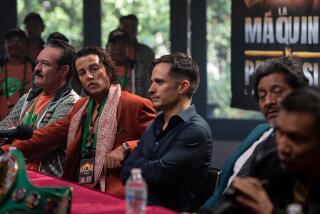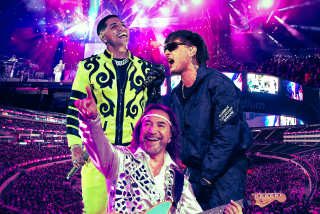New Spanish-Language Station Viva 107 Ready for Its Closeup
The story of the birth of L.A.’s newest radio station--the Spanish-language incarnation of KLYY-FM (107.1), now called Viva 107--is the stuff movies are made of, filled with brilliant underlings, sage-like mentors, the triumph of the underdog, and seemingly divine coincidences.
Though Spanish radio leads the ratings in the Los Angeles-Orange County market, listeners have long complained in surveys of not feeling satisfied with the limited offerings, a fact Viva’s new chief executive, Charles Fernandez, wasted no time capitalizing on. KLYY strategically positioned itself directly between the romantic pop of KLVE-FM (107.5) and the youth-driven dance and pop of KSSE-FM (97.5).
And just a few weeks after Viva’s debut on Dec. 13, KLVE-FM, the market’s second-most-popular station, has added upbeat dance and pop cuts, by artists such as Elvis Crespo, to its previously ballad-centered format.
It’s drama at its best. In fact, based loosely on the facts, we could pitch a compelling script on Viva 107 in a martini meeting to a cool studio exec with a ponytail. (What? Martinis and male ponytails are over, over, over, like the Brian Setzer Orchestra? Got to get out more.)
Anyway, in the opening scene, there’s this large English-language radio station called Y107 on the second floor of a Century City high-rise, foundering hopelessly in the ratings, No. 31 in the market with its alternative-rock format. General sales manager Sean O’Neill, played by a young Wayne Newton, wrings his hands when the dismal Arbitron ratings come in, takes some aspirin, pounds his fist on the wall.
Camera sweeps to Chelina Vargas, O’Neill’s bright young Chicana assistant, played by Salma Hayek. Her long, nearly purple hair falls over one shoulder as she eats lunch, listening, as she often does, to rock in Spanish at her desk. She wears a hip vintage jacket and trendy boots.
Cut to David Howard, general manager, rubbing his chin in deep thought just behind Vargas. He is played by Paul Reiser. What is that music? he asks. It’s an international movement, Vargas says. It sounds amazing, he says; prove it’s got an audience and we’ll give you your own show.
We see a montage of Vargas making calls, doing research on the Internet, meeting people, taking notes, then going home exhausted to Long Beach, where Cypress Hill’s Spanish rap blasts from cars on the street.
Next scene: Vargas in a conference room, outlining the facts: The two top-rated radio stations in Los Angeles are in Spanish. The city is home to the Spanish-language rock movement. See pens fly, signing into life a new show, “The Red Zone,” Sundays from 5 to 7:30 p.m., featuring rock in Spanish, with Vargas as executive producer and Spanish rock band manager Tomas Cookman as producer.
OK, now we see a subplot, with Fernandez, a young family man and entrepreneur in Miami, tapping away at a computer in the offices of his successful company, Hispanic Internet Holdings Inc. He is played by Andy Garcia, pomade and all. He has a history in radio, having worked for the ubiquitous Heftel Spanish broadcasting company, and has a vision of merging his Internet company with a radio company.
Next scene: First night of “Red Zone” broadcast in September. Host Josh Kun, played by Leonardo DiCaprio, attractively disheveled in his T-shirt, black cool-guy pants and hipster eyeglasses, puts his years of academic research on the Mexican rock movement to practical use.
A call comes into the studio. Orale, you guys finally discovered L.A., man, growls the spirit of the barrio--played, of course, by the spooky Edward James Olmos. Atzlan thanks you. It’s like La Virgin and me said to Mr. Carlos Santana that time, play Spanish music, ‘mano, and they’ll come.
Then Fernandez, on the phone, busy, busy, gets the news. He’s in like Flynn. The radio station has merged with his company and he has been named CEO. He enlists a research firm to examine Spanish-language possibilities in Los Angeles for a new radio station.
Mix of Upbeat Pop and Romantic Ballads
The results are conclusive: There is not only room for a new Spanish station, the market is crying for one. The existing stations are very narrow in scope, and conservative, while potential listeners are open to new sounds.
Fernandez contacts Roberto Ibarra, a former Heftel colleague, now working in Spanish radio in Las Vegas, and says he wants to talk business. Ibarra, played by Jimmy Smits or Esai Morales, flies to Los Angeles. They meet and come up with a strategy: Switch to Spanish, play a mix of upbeat pop songs and sweeping romantic ballads, hire the top on-air talent available, including Fernando Gonzalez, who used to be at KSSE, and Javier Renteria, a star from the Tijuana/San Diego area.
Pink slips fly. Furious Anglos, played by Michael J. Fox, Ben Affleck and Gwyneth Paltrow, are shown packing paperweights into cardboard boxes. Soundtrack features Santana’s “Oye Como Va.” As the Anglos exit through the revolving door downstairs, a group of new employees comes in, chatting in Spanish, ranging in age from 20 to 40, led by John Leguizamo, as Renteria.
The next scene takes place one night in December before the party at which the format switch will be formally announced. Vargas and others labor in the office to remove artwork featuring artists such as Oingo Boingo, the Talking Heads and Smashmouth. Exhausted, they watch as workers replace the art with a giant cutout of Jennifer Lopez in silver undies and fuzzy sweater. The old Y107 sign outside the front door to the office is covered with a taped-on, temporary Viva 107 sign.
To the side, Vargas, dressed in black, stares at Lopez’s strangely pursed lips. Kun appears behind her, shakes his head, puts his arms around her. I know, he says. Putting Aterciopelados on the same station as Garbage made sense. It was the same music, different language. But now? How will Los Fabulosos Cadillacs mesh with Carlos Ponce? It’s like a dinner party with Rage Against the Machine and Color Me Bad. Who will want to come?
What’ll we do? Vargas asks.
I don’t know, Kun says, but did I ever tell you I think you’re beautiful when you say the studio phone number on the air in Spanish? Ay, Mamita. (Hey, every movie needs romantic tension, right?)
Expanded ‘Red Zone,’ Hosted Only in Spanish
Articles run in alternative Spanish rock magazines such as La Banda Elastica and PUB about the possible demise of “The Red Zone,” a show that in its short life had garnered international praise from rock-in-Spanish fans. Would the show die, now that the station has gone pop-ola?
OK, we’re getting close to the end here. There’s a scene where O’Neill and Ibarra bump into Vargas and Kun in the hall, and tell them, unexpectedly, they want to expand “The Red Zone” to five hours, but only if the show is now hosted in Spanish, instead of the bilingual mix that defined it.
Billboards for Viva 107 sprout in places where Spanish-speakers will see them, and O’Neill says he’s never seen phones ring so incessantly. Ibarra steps into a bakery in La Puente, and his station is playing over the speakers. He goes to get his hair cut and the ladies in the salon already know the request number by heart. The station is not even a month old.
Final scene will take place in April 2000, when the first Arbitron reports reflecting the switch are published. The scene is in development.
But one thing is certain. Viva will soar past Y107’s weak past, and Spanish radio in Los Angeles will never be the same again.
More to Read
The biggest entertainment stories
Get our big stories about Hollywood, film, television, music, arts, culture and more right in your inbox as soon as they publish.
You may occasionally receive promotional content from the Los Angeles Times.










